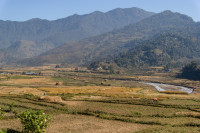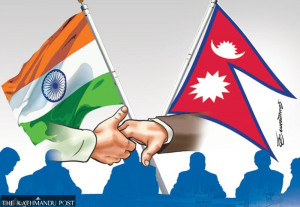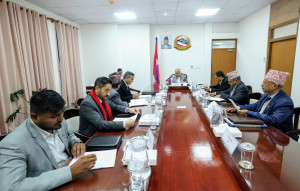Columns
Time to relax capital controls
The question for Nepal is not whether to relax capital controls, but rather when and how to do so.
Chandani Thapa
Nepal’s journey towards global integration is still at an early stage. Until the 1950s, the landlocked country remained largely isolated from the rest of the world. A major turning point was during the balance of payments crisis from 1982 to 1985, which pushed foreign reserves as low as barely three months of import cover. Out of that crisis, Nepal adopted liberalisation, privatisation and globalisation as part of its first generation of reforms under the International Monetary Fund’s Structural Adjustment Programme in the 1990s. So far, Nepal’s globalisation story has been shaped more by migration than by trade or investment. With Nepal set to graduate from Least Developed Country status in 2026, relaxing capital controls is gaining momentum to unlock the next phase of globalisation.
Nepal’s impossible trinity
The Impossible Trinity is a powerful framework for analysing Nepal’s policy tradeoffs. Based on the Mundell-Fleming model, an open economy cannot simultaneously maintain full capital mobility, a fixed exchange rate and an independent monetary policy. It can only ever achieve two out of three goals while giving up the other. Nepal has historically chosen a fixed exchange rate and an independent monetary policy with capital controls.
Capital controls are necessary but restrictive. The Act Restricting Investment Abroad, 1964, remains in force, limiting outbound investment to ensure domestic resources are first channelled towards Nepal’s economic development. However, these restrictions do not constrain inbound investment. In fact, Nepal prioritises attracting foreign direct investment (FDI) under the Foreign Investment and Technology Transfer Act, 2019, and the Federal Industrial Enterprise Act, 2020, albeit subject to minimum investment thresholds and sector-specific equity caps.
Nepal has maintained a fixed exchange rate regime since the 1960s. Given India’s role as Nepal’s largest trading and investment partner, the Nepali rupee (NPR) is pegged to the Indian rupee (INR) to stabilise prices. Although adjustable, the peg of Nepali Rs1.6 to Indian Rs1 has remained unchanged since 1993. Meanwhile, Nepal Rastra Bank (NRB) exercises monetary policy autonomy under the NRB Act, 2002, to maintain macroeconomic stability.
To liberalise or not?
Nepal faces a policy dilemma over its capital controls: Either open up and risk instability or stay closed and risk stagnation. On one side, advocates, including entrepreneurs, tech startups and investors, argue that easing restrictions would integrate Nepal into global markets. Even the former Finance Secretary Rameshwor Khanal-led High-Level Reform Committee Report (2025) recommended revisiting Nepal’s fixed exchange rate regime. On the other side, risks loom large: Capital flight, speculative bubbles and erosion of monetary autonomy. Historical events like the Asian Financial Crisis 1997, as well as leading economists like Jagdish Bhagwati, Joseph Stiglitz and Dani Rodrik, have long warned that premature liberalisation can do more harm than good in developing economies like Nepal.
One policy option for Nepal to open its capital account is to shift its fixed exchange rate regime to a flexible or crawling regime. In such a regime, Nepal could retain monetary autonomy while accommodating free cross-border capital flows. Interest rate adjustments would then affect capital movements and, in turn, the value of currency. The exchange rate would be more sensitive to investor sentiment. However, currency swings introduce volatility that may deter trade, investment and economic growth.
Alternatively, Nepal could allow capital mobility at the cost of sacrificing monetary independence. Any difference between the domestic and Indian interest rates would prompt investors to move funds in search of higher returns, thereby draining foreign exchange reserves and threatening the peg’s stability. To defend the fixed exchange rate, NRB would be compelled to raise interest rates to align with India’s, even when they may be unsuitable for the domestic economy. In effect, Nepal would be tied to India’s monetary stance in a monetary policy straitjacket situation.
Lessons from Asian financial crisis
The Asian Financial Crisis of 1997 is a prime example of twin currency and banking crises despite seemingly strong fundamentals. It began in Thailand when the government abandoned the Baht’s fixed exchange rate to the US dollar under pressure from dwindling reserves. Investor doubts about the country’s ability to defend its currency sparked a speculative attack that quickly escalated into a full-blown crisis. The resulting devaluation triggered a domino effect across Southeast Asia, including Malaysia, Indonesia, South Korea and others. Dealing with the contagion involved recessions, political upheavals and massive IMF bailouts. Three lessons emerge from that crisis for Nepal.
First, the sequencing of reforms matters. The Asian Financial Crisis exposed the dangers of abrupt reversals in capital inflows. International best practices recommend that trade liberalisation should precede capital account liberalisation. While Nepal has achieved trade liberalisation with current account convertibility, capital account liberalisation should only come after strengthening the domestic economy. As of 2023-24, Nepal has faced a high trade deficit with India at 62 percent of total trade, minimal FDI at 0.1 percent of the GDP and soaring remittances at 25 percent of the GDP, driving foreign exchange reserves to a record high. Such figures indicate structural vulnerabilities within Nepal’s economy.
The second is building resilient institutions to ensure financial stability. The Asian Financial Crisis demonstrated how currency crises can quickly spiral into banking crises. Nepal’s financial system may currently lack the strength to absorb volatile capital flows. For instance, the Financial Action Task Force grey-listed Nepal for the second time from February 2025 due to weaknesses in its anti-money laundering and counter-terrorism financing frameworks. Getting out of the grey-list requires implementing much-needed reforms to strengthen microeconomic fundamentals. Nepal can also draw lessons from its neighbours, India and China, who gradually liberalised their capital accounts only after first strengthening domestic fundamentals.
Third is safeguarding exchange-rate stability. The Asian Financial Crisis showed how a sudden loss of a fixed peg can exponentially increase debt-service obligations. Nepal faces a similar risk: External debt makes up over 51.3 percent of total outstanding public debt as of 2024. Recent depreciation of the Nepali currency alone resulted in a debt servicing loss of Rs59 billion. Volatile currency raises the cost of foreign borrowing and thereby squeezes fiscal space needed for productive investment. Having a steady exchange rate is crucial for developing countries like Nepal to remain resilient.
Prudence over haste
The question for Nepal is not whether to relax capital controls, but rather when and how to do so. Nepal cannot have it all: Fixed exchange rate, independent monetary policy and full capital mobility. As calls to ease capital restrictions grow louder, the next phase of Nepal’s globalisation must balance ambition with caution. Nepal’s capital account liberalisation should be gradual, sequenced and rooted in strong economic fundamentals. After all, globalisation rewards the bold but only if they are prepared.




 19.12°C Kathmandu
19.12°C Kathmandu















